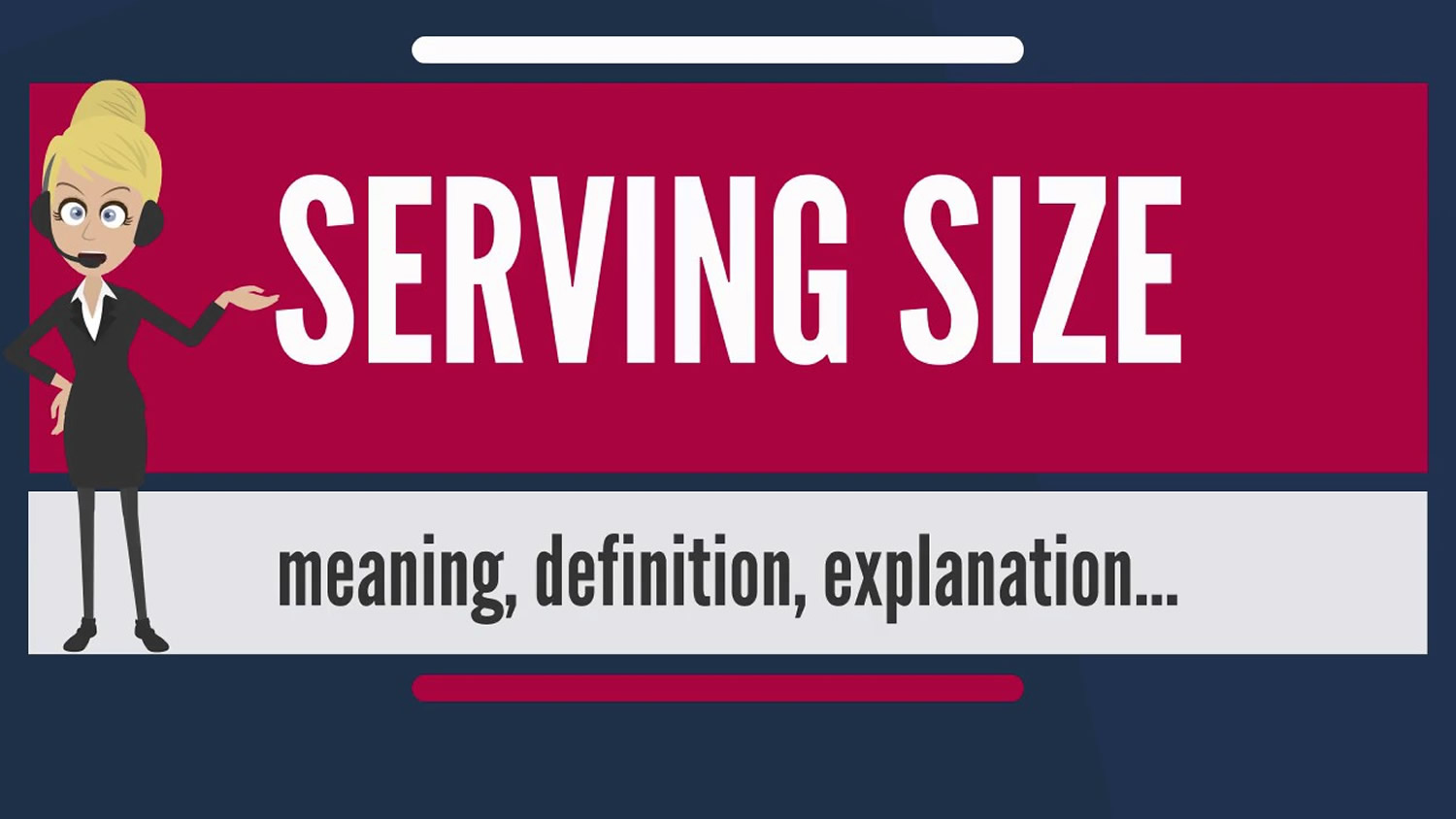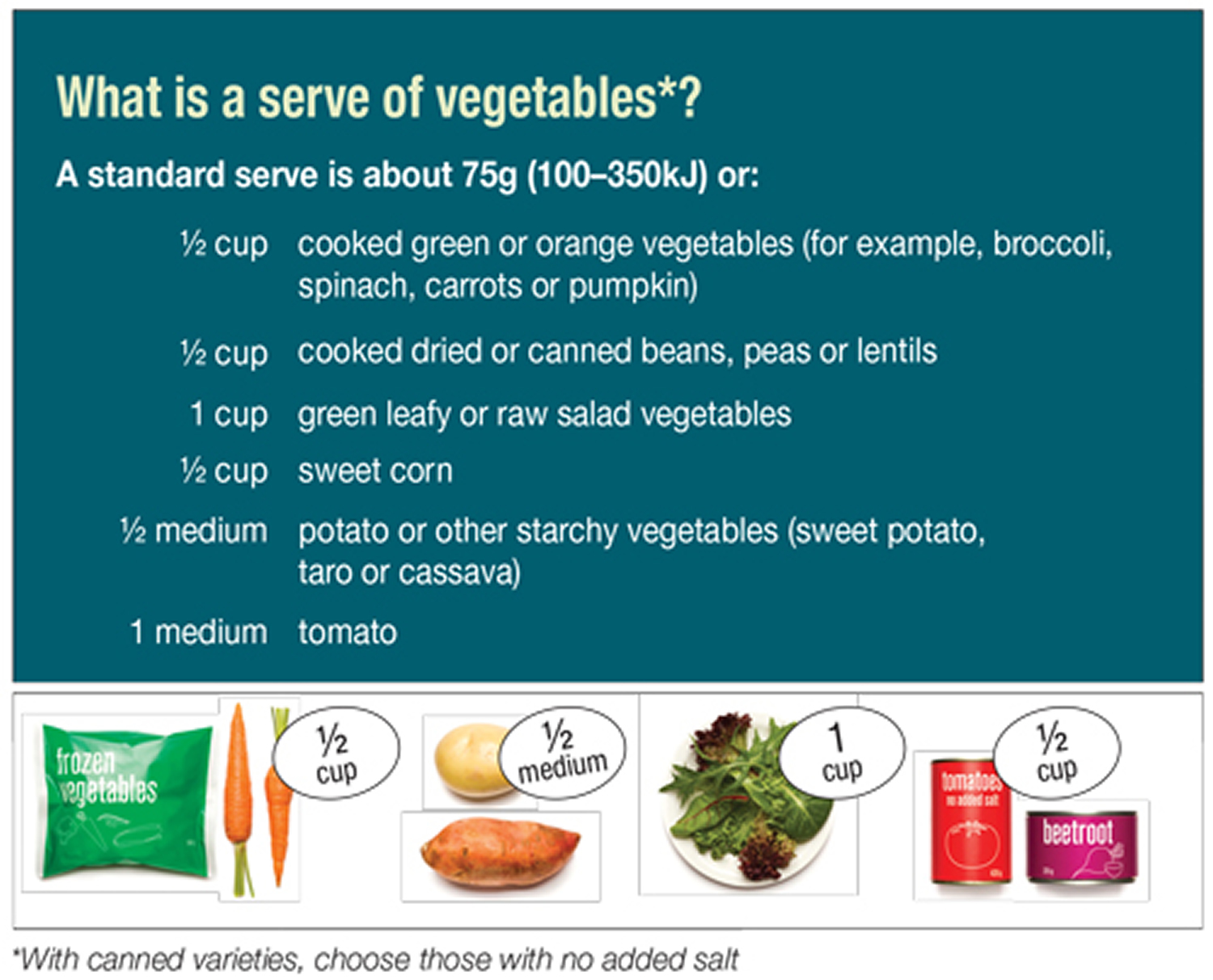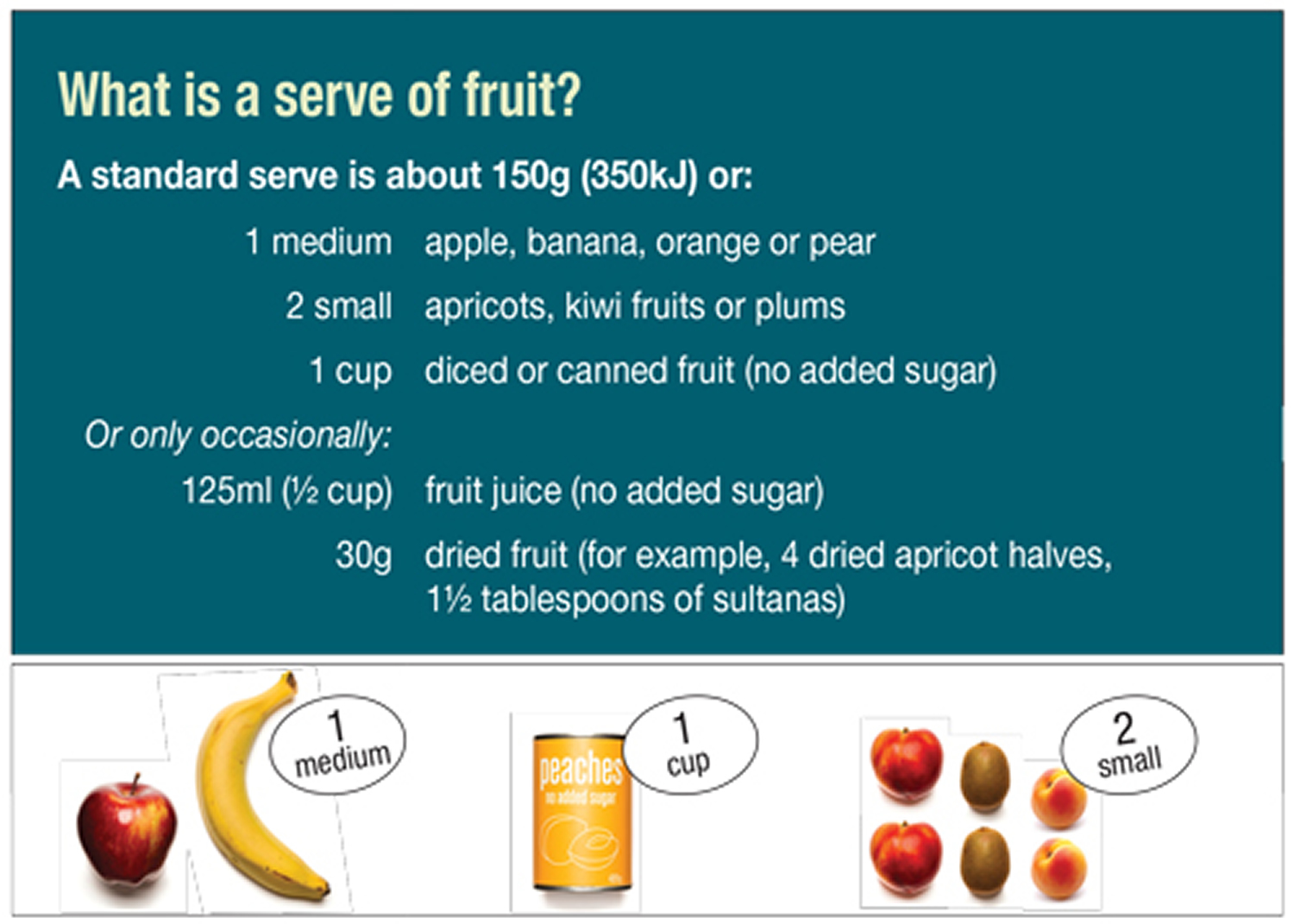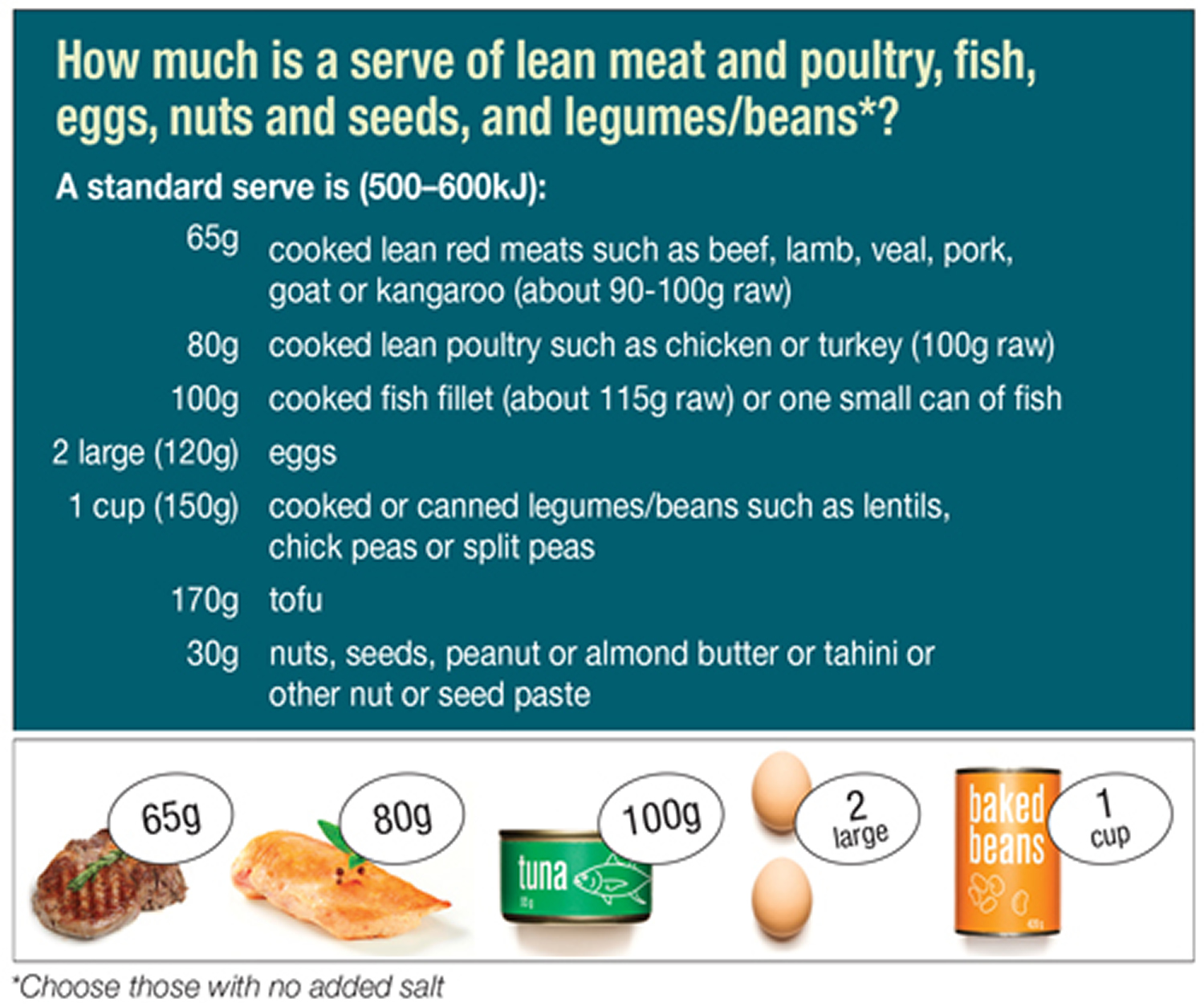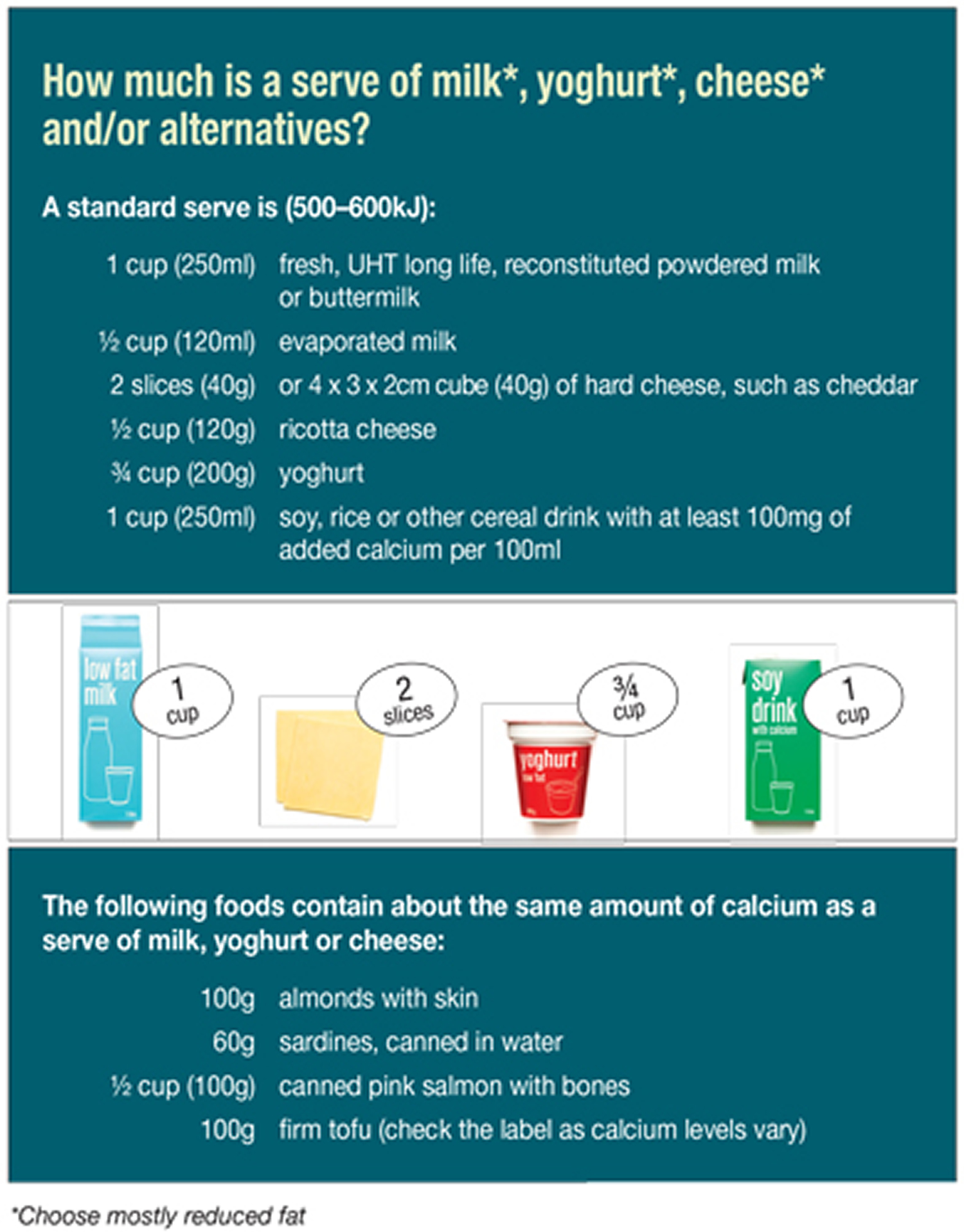Contents
- What is a Serving Size
- 1) What is a serve of vegetables ?
- 2) What is a serve of fruit ?
- 3) What is a serve of rice, pasta and grain* (cereal) food ?
- 4) How much is a serve of lean meat and chicken, fish, eggs, nuts and seeds, and legumes/beans ?
- 5) How much is a serve of milk*, yoghurt*, cheese* and/or alternatives ?
- How many kilojoules are in a serve of each food group ?
- Recommended number of serves for adults
- Recommended number of serves for children, adolescents and toddlers
What is a Serving Size
According to the 2015-2020 Dietary Guidelines for Americans, a serving size is defined as a standardized amount of a food, such as a cup or an ounce, used in providing information about a food within a food group, such as in dietary guidance. Serving size on the Nutrition Facts label is determined based on the Reference Amounts Customarily Consumed for foods that have similar dietary usage, product characteristics, and customarily consumed amounts for consumers to make “like product” comparisons 1.
The American Heart Association define serving size is the amount of food listed on a product’s Nutrition Facts label. So all of the nutritional values you see on the label are for the serving size the manufacturer suggests on the package 2.
The Australian Dietary Guidelines defines the ‘serve size’ as a set amount stated in the Australian Dietary Guidelines and this doesn’t change.
In Dietitians of Canada’s Food Guide, serving size refers to a recommended amount of food for “one Food Guide Serving.” A Food Guide Serving may not be the same as the amount of food you put on your plate. For example, one Food Guide Serving equals 1/2 cup (125 mL) of vegetables. On a Nutrition Facts table, the serving size refers to a specific amount of food that all of the label information is based on 3.
A Dietitians of Canada’s Food Guide Serving is simply a reference amount. It helps you understand how much food is recommended every day from each of the four food groups. In some cases, a Dietitians of Canada’s Food Guide Serving may be close to what you eat, such as an apple. In other cases, such as rice or pasta, you may serve yourself more than one Dietitians of Canada’s Food Guide Serving.
Look at the examples below to find out how much food is equal to one Food Guide Serving.
Examples of one Dietitians of Canada’s Food Guide Serving are:
Vegetables and Fruit
- 125 mL (½ cup) fresh, frozen or canned
- vegetable or fruit or 100% juice
- 250 mL (1 cup) leafy raw vegetables or
- salad
- 1 piece of fruit
Grain Products
- 1 slice (35 g) bread or ½ bagel (45 g)
- ½ pita (35 g) or ½ tortilla (35 g)
- 125 mL (½ cup) cooked rice, pasta, or couscous
- 30 g cold cereal or 175 mL (¾ cup) hot cereal
Milk and Alternatives
- 250 mL (1 cup) milk or fortified soy beverage
- 175 g (¾ cup) yogurt
- 50 g (1 ½ oz.) cheese
Meat and Alternatives
- 75 g (2 ½ oz.)/125 mL (½ cup) cooked fish, shellfish, poultry or lean meat
- 175 mL (¾ cup) cooked beans
- 2 eggs
- 30 mL (2 Tbsp) peanut butter
A recommended serving size is the amount of each food that you are supposed to eat during a meal or snack 4.
And a Portion Size—is defined as the amount of a food served or consumed in one eating occasion. A portion is not a standardized amount and the amount considered to be a portion is subjective and varies 1. Since the 1970s, portion sizes have increased both for food eaten at home and for food eaten away from home, in adults and children 5, 6. Short-term studies clearly demonstrate that when people are served larger portions, they eat more. One study, for example, gave moviegoers containers of stale popcorn in either large or medium-sized buckets; people reported that they did not like the taste of the popcorn-and even so, those who received large containers ate about 30 percent more popcorn than those who received medium-sized containers 7. Another study showed that people given larger beverages tended to drink significantly more, but did not decrease their subsequent food consumption 8. An additional study provided evidence that when provided with larger portion sizes, people tended to eat more, with no decrease in later food intake 9. Several well-controlled, laboratory-based studies have shown that providing older children and adults with larger food portions can lead to significant increases in energy intake. This effect has been demonstrated for snacks and a variety of single meals and shown to persist over a 2-day period. Despite increases in intake, individuals presented with large portions generally do not report or respond to increased levels of fullness, suggesting that hunger and satiety signals are ignored or overridden 10.
Once you understand the difference a serving size and portion size, it’s easier to determine how much to serve and easier to teach kids the difference between the two. Learn some suggested servings from each food groups you and your kids can eat at mealtime or between meals.
The following serving sizes are derived from the Australian Dietary Guidelines 11.
1) What is a serve of vegetables ?
A standard serve is about 75g (100–350kJ) or:
- ½ cup cooked green or orange vegetables (for example, broccoli, spinach, carrots or pumpkin)
- ½ cup cooked dried or canned beans, peas or lentils (preferably with no added salt)
- 1 cup green leafy or raw salad vegetables
- ½ cup sweet corn
- ½ medium potato or other starchy vegetables (sweet potato, taro or cassava)
- 1 medium tomato
2) What is a serve of fruit ?
A standard serve is about 150g (350kJ) or:
- 1 medium apple, banana, orange or pear
- 2 small apricots, kiwi fruits or plums
- 1 cup diced or canned fruit (no added sugar)
Or only occasionally:
- 125ml (½ cup) fruit juice (no added sugar)
- 30g dried fruit (for example, 4 dried apricot halves, 1½ tablespoons of sultanas)
3) What is a serve of rice, pasta and grain* (cereal) food ?
A standard serve is (500kJ) or:
- 1 slice (40g) bread
- ½ medium (40g) roll or flat bread
- ½ cup (75-120g) cooked rice, pasta, noodles, barley, buckwheat, semolina, polenta, bulgur or quinoa
- ½ cup (120g) cooked porridge
- ²/³ cup (30g) wheat cereal flakes
- ¼ cup (30g) muesli
- 3 (35g) crispbreads
- 1 (60g) crumpet
- 1 small (35g) English muffin or scone
*Grain (cereal) foods, mostly wholegrain and/or high cereal fibre varieties
4) How much is a serve of lean meat and chicken, fish, eggs, nuts and seeds, and legumes/beans ?
A standard serve is (500–600kJ):
- 65g cooked lean red meats such as beef, lamb, veal, pork, goat or kangaroo (about 90-100g raw)
- 80g cooked lean poultry such as chicken or turkey (100g raw)
- 100g cooked fish fillet (about 115g raw) or one small can of fish
- 2 large (120g) eggs
- 1 cup (150g) cooked or canned legumes/beans such as lentils, chick peas or split peas (preferably with no added salt)
- 170g tofu
- 30g nuts, seeds, peanut or almond butter or tahini or other nut or seed paste (no added salt)*
*Only to be used occasionally as a substitute for other foods in the group (note: this amount for nuts and seeds gives approximately the same amount of energy as the other foods in this group but will provide less protein, iron or zinc).
5) How much is a serve of milk*, yoghurt*, cheese* and/or alternatives ?
A standard serve is (500–600kJ):
- 1 cup (250ml) fresh, UHT long life, reconstituted powdered milk or buttermilk
- ½ cup (120ml) evaporated milk
- 2 slices (40g) or 4 x 3 x 2cm cube (40g) of hard cheese, such as cheddar
- ½ cup (120g) ricotta cheese
- ¾ cup (200g) yoghurt
- 1 cup (250ml) soy, rice or other cereal drink with at least 100mg of added calcium per 100ml
*Choose mostly reduced fat
If you do not eat any foods from this group, try the following foods, which contain about the same amount of calcium as a serve of milk, yoghurt, cheese or alternatives (note: the kilojoule content of some of these serves (especially nuts) is higher so watch this if trying to lose weight).
- 100g almonds with skin
- 60g sardines, canned in water
- ½ cup (100g) canned pink salmon with bones
- 100g firm tofu (check the label as calcium levels vary)
How many kilojoules are in a serve of each food group ?
- Not all food groups provide the same number of kilojoules (kJ) per serve.
A serve of the grain (cereals) food group; milks/yoghurt/cheese and /or alternatives group; lean meats, poultry, fish, eggs and/or alternatives group; will provide about 500-600kJ.
About 2 serves of fruit, and from 2 serves (for starchy vegetables) to 5 serves (of green leafy vegetables) of different varieties in the vegetables group will provide about 500-600kJ. This is one reason that it makes good sense to fill up on leafy green and other lower kilojoule vegetables when you are trying to lose weight.
Also, while discretionary food serves can have similar kilojoules (about 600kJ) to a serve of the five food groups, they are usually much smaller and less filling, don’t provide you with the fibre and nutrients you need and contain too much saturated fat, added sugars and added salt for good health.
Recommended number of serves for adults
The dietary patterns in the table below provide the nutrients and energy needed by all men and women of average height with sedentary to moderate activity levels. Additional serves of the Five Food Groups or unsaturated spreads and oils or discretionary choices are needed only by adults who are taller, more active or in the higher end of a particular age band, to meet additional energy requirements.
| Recommended average daily number of serves from each of the five food groups* | Additional serves for taller or more active men and women | |||||
| Vegetables & legumes/beans | Fruit | Grain (cereal) foods, mostly wholegrain | Lean meat and poultry, fish, eggs, nuts and seeds, and legumes/beans | Milk, yoghurt, cheese and/or alternatives (mostly reduced fat) | Approx. number of additional serves from the five food groups or discretionary choices | |
|---|---|---|---|---|---|---|
| Men | ||||||
| 19-50 | 6 | 2 | 6 | 3 | 2 ½ | 0-3 |
| 51-70 | 5 ½ | 2 | 6 | 2 ½ | 2 ½ | 0-2 ½ |
| 70+ | 5 | 2 | 4 ½ | 2 ½ | 3 ½ | 0-2 ½ |
| Women | ||||||
| 19-50 | 5 | 2 | 6 | 2 ½ | 2 ½ | 0-2 ½ |
| 51-70 | 5 | 2 | 4 | 2 | 4 | 0-2 ½ |
| 70+ | 5 | 2 | 3 | 2 | 4 | 0-2 |
| Pregnant | 5 | 2 | 8 ½ | 3 ½ | 2 ½ | 0-2 ½ |
| Lactating | 7 ½ | 2 | 9 | 2 ½ | 2 ½ | 0-2 ½ |
* Includes an allowance for unsaturated spreads or oils, nuts or seeds (4 serves [28-40g] per day for men less than 70 years of age; 2 serves [14-20g] per day for women and older men.)
(Source: National Health and Medical Research Council of Australia. Recommended number of serves for adults. 12).
Recommended number of serves for children, adolescents and toddlers
The dietary patterns in the table below provide the nutrients and energy needed for all children and adolescents of average height with sedentary to moderate activity levels.
Additional serves of the Five Food Groups or unsaturated spreads and oils or discretionary choices are needed only by children and adolescents who are taller, more active or in the higher end of a particular age band, to meet additional energy requirements.
| Recommended average daily number of serves from each of the five food groups* | Additional serves for more active, taller or older children and adolescents | |||||
| Vegetables & legumes/beans | Fruit | Grain (cereal) foods, mostly wholegrain | Lean meat and poultry, fish, eggs, nuts and seeds, and legumes/beans | Milk, yoghurt, cheese and/or alternatives (mostly reduced fat) | Approx. number of additional serves from the five food groups or discretionary choices | |
|---|---|---|---|---|---|---|
| Toddlers ** | ||||||
| 1-2 | 2-3 | ½ | 4 | 1 | 1-1½ | |
| Boys | ||||||
| 2-3 | 2 ½ | 1 | 4 | 1 | 1 ½ | 0-1 |
| 4-8 | 4 ½ | 1 ½ | 4 | 1 ½ | 2 | 0-2 ½ |
| 9-11 | 5 | 2 | 5 | 2 ½ | 2 ½ | 0-3 |
| 12-13 | 5 ½ | 2 | 6 | 2 ½ | 3 ½ | 0-3 |
| 14-18 | 5 ½ | 2 | 7 | 2 ½ | 3 ½ | 0-5 |
| Girls | ||||||
| 2-3 | 2 ½ | 1 | 4 | 1 | 1 ½ | 0-1 |
| 4-8 | 4 ½ | 1 ½ | 4 | 1 ½ | 1 ½ | 0-1 |
| 9-11 | 5 | 2 | 4 | 2 ½ | 3 | 0-3 |
| 12-13 | 5 | 2 | 5 | 2 ½ | 3 ½ | 0-2 ½ |
| 14-18 | 5 | 2 | 7 | 2 ½ | 3 ½ | 0-2 ½ |
| Pregnant | 5 | 2 | 8 | 3 ½ | 3 ½ | 0-3 |
| Breastfeeding | 5 ½ | 2 | 9 | 2 ½ | 4 | 0-3 |
*Includes an allowance for unsaturated spreads or oils, nuts or seeds (½ serve [4.5g] per day for children 2-3 years of age, 1 serve [7-10g] per day for children 3-12 years of age; 1 ½ serves [11-15g] per day for children 12-13 years, and 2 serves [14-20g] per day for adolescents 14-18 years of age and for pregnant and breastfeeding girls).
** An allowance for unsaturated spreads or oils or nut/seed paste of 1 serve (7–10g) per day is included. Whole nuts and seeds are not recommended for children of this age because of the potential choking risk.
(Source: National Health and Medical Research Council of Australia. Recommended number of serves for children, adolescents and toddlers. 13).
- 2015–2020 Dietary Guidelines for Americans. https://health.gov/dietaryguidelines/2015/[↩][↩]
- The American Heart Association. Portion Size Versus Serving Size. http://www.heart.org/HEARTORG/HealthyLiving/HealthyKids/HowtoMakeaHealthyHome/Portion-size-versus-serving-size—Whats-the-difference-for-kids_UCM_304051_Article.jsp[↩]
- Dietitians of Canada. Serving size. https://www.dietitians.ca/Your-Health/Nutrition-A-Z/Serving-size.aspx[↩]
- U.S. National Library of Medicine, Medline Plus. Portion size. https://medlineplus.gov/ency/patientinstructions/000337.htm[↩]
- Nielsen SJ, Popkin BM. Patterns and trends in food portion sizes, 1977-1998. JAMA. 2003;289:450-3. https://www.ncbi.nlm.nih.gov/pubmed/12533124[↩]
- Piernas C, Popkin BM. Food portion patterns and trends among U.S. children and the relationship to total eating occasion size, 1977-2006. J Nutr. 2011;141:1159-64. https://www.ncbi.nlm.nih.gov/pubmed/21525258[↩]
- Wansink B, Kim J. Bad popcorn in big buckets: portion size can influence intake as much as taste. J Nutr Educ Behav. 2005;37:242-5. https://www.ncbi.nlm.nih.gov/pubmed/16053812[↩]
- Rolls, B. J., L. S. Roe, et al. (2007). “The effect of large portion sizes on energy intake is sustained for 11 days.” Obesity (Silver Spring) 15(6): 1535-1543.[↩]
- Rosenheck R. Fast food consumption and increased caloric intake: a systematic review of a trajectory towards weight gain and obesity risk. Obes Rev. 2008;9:535-47. https://www.ncbi.nlm.nih.gov/pubmed/18346099[↩]
- Ello-Martin JA, Ledikwe JH, Rolls BJ. The influence of food portion size and energy density on energy intake: implications for weight management. Am J Clin Nutr. 2005;82(Suppl 1):236S–241S. https://www.ncbi.nlm.nih.gov/pubmed/16002828[↩]
- The Australian Dietary Guidelines. Serve sizes. https://www.eatforhealth.gov.au/food-essentials/how-much-do-we-need-each-day/serve-sizes[↩]
- National Health and Medical Research Council of Australia. Recommended number of serves for adults. https://www.eatforhealth.gov.au/food-essentials/how-much-do-we-need-each-day/recommended-number-serves-adults[↩]
- National Health and Medical Research Council of Australia. Recommended number of serves for children, adolescents and toddlers. https://www.eatforhealth.gov.au/food-essentials/how-much-do-we-need-each-day/recommended-number-serves-children-adolescents-and[↩]
